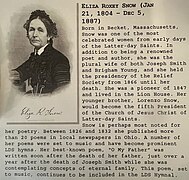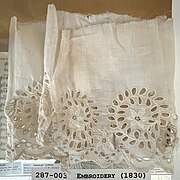Eliza R. Snow
| Eliza Roxey Snow | |
|---|---|
Eliza Roxey Snow (1870) | |
| 2nd Relief Society General President | |
| December 1866[1][2] – December 5, 1887[3] | |
| Predecessor | Emma Smith |
| Successor | Zina D. H. Young |
| 1st Secretary of the Relief Society | |
| 1842 – 1844 | |
| Personal details | |
| Born | Eliza Roxey Snow January 21, 1804 Joseph Smith Jr (1842–44; sealed) Brigham Young (1844–77; deceased) |
| Signature | |
 | |
Eliza Roxey Snow (January 21, 1804 – December 5, 1887) was one of the most celebrated
Early years and education
Eliza Roxey Snow was born in
Although a farmer by occupation, Oliver Snow performed much public business, officiating in several responsible positions. His daughter, Eliza, being ten years the senior of her eldest brother, was employed as secretary,
Early church involvement
Snow's
Snow moved west with her family and the body of the church, first to
In Nauvoo, Snow again made her living as a school teacher. After Smith's death, Snow stated she had secretly wed him on June 29, 1842, as a plural wife. Snow wrote fondly of Smith, "my beloved husband, the choice of my heart and the crown of my life".[7] However, Snow had organized a petition in that same summer of 1842, with a thousand female signatures, denying that Smith was connected with polygamy and extolling his virtue.[8] As secretary of the Ladies' Relief Society, she organized the publishing of a certificate in October 1842 denouncing polygamy and denying Smith as its creator or participant.[9] Years later, when Snow was informed that Smith's first wife, Emma, had stated on her deathbed that her husband had never been a polygamist. Snow was reported to have stated she doubted the story but "If ... [this] was really [Sister Emma's] testimony she died with a libel on her lips".[10]
After Smith's death, Snow married Brigham Young as a plural wife. She traveled west across the plains and arrived in the
Relief Society service

The first Relief Society of the LDS Church was organized by Joseph Smith in Nauvoo, Illinois on March 17, 1842, as a philanthropic and women's educational organization.[11] Snow served as the organization's first secretary, with Smith's wife, Emma, as president. The organization was originally known as "The Female Relief Society of Nauvoo."[12] It later became known simply as "The Relief Society." For the next three years, Snow kept copious notes of the organization's meetings, including Joseph Smith's teachings on how the organization should operate. Members of the original Relief Society stopped meeting shortly after Smith's death in 1844, and the organization soon became defunct.[11]
Brigham Young led a migration of LDS Church members to the Salt Lake Valley in 1847, and for the next twenty years attempts were periodically made to reestablish the organization. Until 1868, however, activity was limited, and no sustained, church-wide Relief Society existed.[13]
In 1868, Young commissioned Snow with reestablishing the Relief Society. For the next several years, Snow traveled throughout the Utah Territory helping Latter-day Saint bishops again organize Relief Society in their local wards, using the notes she took as secretary in Nauvoo as the founding principles of the reestablished Relief Society.[14] "What is the object of the Female Relief Society?" Snow wrote on one occasion. "I would reply—to do good—to bring into requisition every capacity we possess for doing good, not only in relieving the poor but in saving souls."[15] Local Relief Societies soon fell under the umbrella of a church-wide, general Relief Society of which Snow served as president until 1887.[14]
Snow's presidency emphasized spirituality and self-sufficiency. The Relief Society sent women to medical school, trained nurses, opened the Deseret Hospital, operated cooperative stores, promoted silk manufacture, saved wheat, and built granaries. In 1872, Snow provided assistance and advice to
Snow served as president of the Relief Society until her death in 1887. By 1888, the Relief Society had more than 22,000 members in 400 local congregations.
Snow died in Salt Lake City, and was buried in
Poetry
Snow wrote poetry from a young age, one time even writing school lessons in rhyme. Between 1826 and 1832, she published more than 20 poems in local newspapers under various pen names, including the Western Courier of
In Nauvoo, Snow gained unique distinction as a Mormon poet featured in local newspapers, and she was later called "Zion's Poetess." She continued to write poems as she journeyed to the Salt Lake Valley, documenting the pioneer trail and life in Utah. The first of her two volumes of Poems, Religious, Historical, and Political appeared in 1856, followed by the second in 1877. Some of her poems are:
- "How Great the Wisdom and the Love"[16]
- "Invocation, or the Eternal Father and Mother" [retitled "O My Father"][17]
- "Be Not Discouraged"[18]
- "My First View of a Western Prairie"[19]
- "Mental Gas"[20]
- "Think not When You Gather to Zion Your Troubles and Trials are Through"
- "O Awake! My Slumbering Minstrel"
One of her best-known poems, "Invocation, or the Eternal Father and Mother," was written soon after the death of her father and just over a year after the death of Joseph Smith.[21] The poem, renamed "O My Father" after the first line, is included in the LDS Church's current hymnal, as are Snow's hymns "Great is the Lord"; "Again We Meet Around the Board"; "Awake, Ye Saints of God, Awake!"; "How Great the Wisdom and the Love"; "The Time Is Far Spent"; "In Our Lovely Deseret"; "Though Deepening Trials"; "Behold the Great Redeemer Die"; and "Truth Reflects Upon Our Senses".
Eliza Snow and her brother, Lorenzo Snow, founded the Polysophical Society in December 1854 in Salt Lake City. Members shared poetry and musical and dramatic performances. Church leaders Jedediah M. Grant and Heber C. Kimball halted the society's activities because of its "adulterous spirit."[22]
Image gallery
-
Snow's biographical sketch at the Pioneer Memorial Museum (PMM)
-
Snow (by Ortho R. Fairbanks; 1952) in front of the PMM
-
Snow's embroidery (1830) in the PMM
-
Snow’s pocket watch from Joseph Smith, located in the Church History Museum
-
Snow (by Lewis Aquilla Ramsey; 1909)
-
Snow (by Charles Roscoe Savage & George Martin Ottinger)
-
Snow (by Danquart Anthon Weggeland; 1883) in the PMM
-
Snow (by Edward Martin)
-
Snow (by Marsena Cannon; 1852)
-
Snow (by Hippolyte Délié & Emile Béchard; 1873)
Publications
- Snow, Eliza R. (1856). Poems: Religious, Historical and Political, Volume 1. Liverpool: F.D. Richards. OCLC 6549748.
- OCLC 85796473.
- Snow, Eliza R. (1877). Poems: Religious, Historical and Political, Volume 2. Salt Lake City: The Latter-day Saints Printing and Publishing Establishment. OCLC 6549777.
- —— (1880). Hymns and Songs: Selected From Various Authors, for the Primary Associations of the Children of Zion. Salt Lake City: Deseret News. OCLC 5330531.
- —— (1880). Children's Primary Tune Book. Salt Lake City: Juvenile Instructor Office.
- —— (1881). Bible Questions and Answers for Children. Salt Lake City: Juvenile Instructor Office. OCLC 228702929.
- —— (1884). Biography and Family Record of Lorenzo Snow, One of the Twelve Apostles of the Church of Jesus Christ of Latter-day Saints. Salt Lake City: Deseret News. OCLC 4623484.
Relief Society Magazine
This section's use of external links may not follow Wikipedia's policies or guidelines. (January 2018) |
Articles
- "The Mother of Mothers in Israel". Relief Society Magazine. 3 (4): 183–190. April 1916.
- "Sketch of My Life I". Relief Society Magazine. 31 (3): 131–136. March 1944.
- "Sketch of My Life II". Relief Society Magazine. 31 (4): 207–214. April 1944.
- "Sketch of My Life III". Relief Society Magazine. 31 (5): 272–278. May 1944.
- "Sketch of My Life IV". Relief Society Magazine. 31 (6): 312–314, 351. June 1944.
- "Sketch of My Life V". Relief Society Magazine. 31 (7): 392–394. July 1944.
- "Sketch of My Life VI". Relief Society Magazine. 31 (8): 450–453. August 1944.
- "Sketch of My Life VI". Relief Society Magazine. 31 (9): 504–505. September 1944.
- "Sketch of My Life VII". Relief Society Magazine. 31 (10): 578–581. October 1944.
Poetry
- "My Epitaph". Relief Society Magazine. 3 (4): 181. April 1916.
- "Zion Prospers, All is Well". Relief Society Magazine. 3 (4): 190. April 1916.
- "A Tribute to the Birthday of the Prophet Joseph Smith". Relief Society Magazine. 4 (12): 663–665. December 1917.
- "Apostrophe to Jerusalem". Relief Society Magazine. 5 (8): 439–441. August 1918.
- "The Year Has Gone". Relief Society Magazine. 12 (1): 1. January 1925.
Posthumous publications
See also
References
- OCLC 24502140.once more saw need for the Women to be organized, and called Eliza R Snow to "head up" the movement, this time on an all-church basis.
In December 1866, following the Civil War, President Young
- ^ a b Although Snow was the churchwide leader of the Relief Society since 1866 or 1867, she was not officially sustained as its president until June 19, 1880, following the death of Emma Smith, the first such president. See:
- Roseann Benson (2011). "Primary Association Pioneers: An Early History". In David J. Whittaker; Arnold K. Garr (eds.). A Firm Foundation: Church Organization and Administration. Religious Studies Center. Retrieved 2015-08-27.
- Carol Cornwall Madsen (2004). "The 'Elect Lady' Revelation (D&C 25): Its Historical and Doctrinal Context". In Craig K. Manscill (ed.). Sperry Symposium Classics: The Doctrine and Covenants. Religious Studies Center. Retrieved 2015-08-27.
- Jill Mulvay Derr; Janath R. Cannon (1992). "Relief Society". Encyclopedia of Mormonism. Macmillan. Archived from the original on 2018-09-23. Retrieved 2015-08-27.
- ^ "Appendix 1: Biographical Register of General Church Officers". Encyclopedia of Mormonism. p. 1647.
- ^ a b c Tullidge, Edward, W. (1881). Tullidge's Quarterly Magazine, Vol. 1. Salt Lake City, Utah: Edward W. Tullidge. pp. 116–.
{{cite book}}: CS1 maint: multiple names: authors list (link) - ^ a b c d e "Death of Sister E. R. Snow Smith Obituary". Deseret News. December 5, 1887.
- ^ a b Peggy Fletcher Stack, "Shocking historical finding: Mormon icon Eliza R. Snow was gang-raped by Missouri ruffians", The Salt Lake Tribune, 3 March 2016.
- ^ "The Significance of "O My Father" in the Personal Journey of Eliza R. Snow" (PDF). BYU Studies. 36 (1). Brigham Young University: 87. Archived from the original on October 21, 2013. Retrieved April 24, 2017.
- ^ Times and Seasons 3 (August 1, 1842): 869.
- ^ Times and Seasons 3 (October 1, 1842): 940.
- Women's Exponent.[full citation needed]
- ^ ISBN 9781629721507.
- ISBN 9781629721507.
- ISBN 9781629721507.
- ^ ISBN 9781629721507.
- ISBN 9781629721507.
- ^ How Great the Wisdom and the Love, Mormon Literature Website, BYU
- ^ Invocation, or the Eternal Father and Mother, Mormon Literature Website, BYU
- ^ Be Not Discouraged, Mormon Literature Website, BYU
- ^ My First View of a Western Prairie, Mormon Literature Website, BYU
- ^ Mental Gas, Mormon Literature Website, BYU
- ^ Snow, E.R. "My Father in Heaven", Times and Seasons 6 (November 15, 1845).
- ^ Christensen, McKenzi. "The Polysophical Society". Intermountain Histories.
Bibliography
 This article incorporates text from this source, which is in the public domain: Tullidge, Edward W. (1881). Tullidge's Quarterly Magazine. Vol. 1 (Public domain ed.). Salt Lake City, Utah: Edward W. Tullidge.
This article incorporates text from this source, which is in the public domain: Tullidge, Edward W. (1881). Tullidge's Quarterly Magazine. Vol. 1 (Public domain ed.). Salt Lake City, Utah: Edward W. Tullidge.
Further reading
- Karen Lynn Davidson, Jill Mulvay Derr, Eliza R. Snow: The Complete Poetry, (Brigham Young University Press, 2018)
- The Life and Labors of Eliza R. Snow Smith: with a full account of her funeral services. Salt Lake City: OCLC 10352533.
- Palmer, Spencer J., Editor. "Eliza R. Snow's 'Sketch of my Life': Reminiscences of One of Joseph Smith's Plural Wives." BYU Studies 12 (Autumn 1971).













